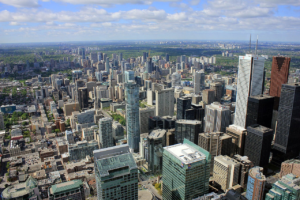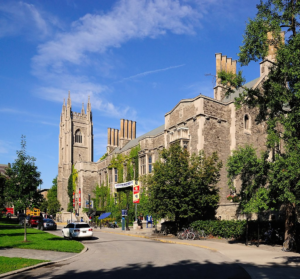
Ontario is one of the thirteen provinces and territories of Canada. Located in Central Canada, it is Canada’s most populous province, with 38.3 percent of the country’s population, and is the second-largest province by total area (after Quebec). Ontario is Canada’s fourth-largest jurisdiction in total area when the territories of the Northwest Territories and Nunavut are included. It is home to the nation’s capital city, Ottawa, and the nation’s most populous city, Toronto, which is also Ontario’s provincial capital.
Ontario is bordered by the province of Manitoba to the west, Hudson Bay and James Bay to the north, and Quebec to the east and northeast, and to the south by the U.S. states of (from west to east) Minnesota, Michigan, Ohio, Pennsylvania, and New York. Almost all of Ontario’s 2,700 km (1,678 mi) border with the United States follows inland waterways: from the westerly Lake of the Woods, eastward along the major rivers and lakes of the Great Lakes/Saint Lawrence River drainage system. Ontario is sometimes divided into two geographic regions, Northern Ontario and Southern Ontario. The great majority of Ontario’s population and arable land is in the south. In contrast, the larger, northern part of Ontario is sparsely populated with cold winters and heavy forestation.
The Ontario Legislative Building at Queen's Park
Ontario’s climate varies by season and location. Three air sources affect it: cold, dry, arctic air from the north (dominant factor during the winter months, and for a longer part of the year in far northern Ontario); Pacific polar air crossing in from the western Canadian Prairies/US Northern Plains; and warm, moist air from the Gulf of Mexico and the Atlantic Ocean. The effects of these major air masses on temperature and precipitation depend mainly on latitude, proximity to major bodies of water and to a small extent, terrain relief. In general, most of Ontario’s climate is classified as humid continental.
Ontario has four main climatic regions:
Southern Ontario, has warm to hot, humid summers and cold winters. Central and Eastern Ontario, has warm and sometimes hot summers with colder, longer winters, ample snowfall. Northeastern part of the Niagara Peninsula, which has a temperate humid climate.The northernmost parts of Ontario – primarily north of 50°N – have a subarctic climate with long, severely cold winters and short, cool to warm summers with dramatic temperature changes possible in all seasons.

Photo: Toronto’s Financial District
Ontario is Canada’s leading manufacturing province. Ontario’s largest trading partner is the American state of Michigan. Mining and the forest products industry, notably pulp and paper, are vital to the economy of Northern Ontario. An abundance of natural resources, excellent transportation links to the North American heartland and the inland Great Lakes making ocean access possible via container ships, have all contributed to making manufacturing the principal industry of the province, found mainly in the Golden Horseshoe region, which is the largest industrialized area in Canada, the southern end of the region being part of the North American Rust Belt. Important products include motor vehicles, iron, steel, food, electrical appliances, machinery, chemicals, and paper.
In car production, Ontario has Chrysler plants in Windsor and Bramalea, two GM plants in Oshawa and one in Ingersoll, a Honda assembly plant in Alliston, Ford plants in Oakville and St. Thomas and Toyota assembly plants in Cambridge and Woodstock.
Toronto, the capital of Ontario, is the center of Canada’s financial services and banking industry. Neighboring cities are home to product distribution, IT centers, and manufacturing industries. Canada’s Federal Government is the largest single employer in the National Capital Region, which centers on the border cities of Ontario’s Ottawa and Quebec’s Gatineau.
The information technology sector is important, particularly in the Silicon Valley North section of Ottawa, home to Canada’s largest technology park.
Tourism contributes heavily to the economy of Central Ontario, peaking during the summer months owing to the abundance of fresh water recreation and wilderness found there in reasonable proximity to the major urban centers. At other times of the year, hunting, skiing and snowmobiling are popular. This region has some of the most vibrant fall color displays anywhere on the continent, and tours directed at overseas visitors are organized to see them. Tourism also plays a key role in border cities with large casinos, among them Windsor, Cornwall, Sarnia and Niagara Falls, the latter of which attracts millions of US and other international visitors.
Important airports in the province include Toronto Pearson International Airport, which is the busiest airport in Canada. Ottawa Macdonald–Cartier International Airport is Ontario’s second largest airport.
There are several city rail-transit systems in the Province. The Toronto Transit Commission operates subways, as well as streetcars (being one of the busiest streetcar systems in North America). OC Transpo operates a light rail metro system in Ottawa. In addition, Waterloo region operates a surface light rail system. Plans to build a light rail line is also underway in the Regional Municipality of Peel.

Photo: University of Toronto. The University of Toronto has the largest student population of any university in Canada.
Publicly funded elementary and secondary schools are administered by the Ontario Ministry of Education, while colleges and universities are administered by the Ontario Ministry of Training, Colleges and Universities.
Higher education in Ontario includes postsecondary education and skills training regulated by the Ministry of Training, Colleges, and Universities and provided by universities, colleges of applied arts and technology, and private career colleges.
There are 22 publicly funded universities in the Canadian province of Ontario that are post-secondary education institutions with degree-granting authority. Each of these institutions were either established through an Act of the Legislative Assembly or through a Royal Charter. With the exception of Royal Military College of Canada, students apply to public universities in Ontario through the Ontario Universities’ Application Centre.
Ontario also has 24 publicly funded colleges, most referred to as Colleges of Applied Arts and Technology and five as Institutes of Technology and Advanced Learning, all of which are commonly referred to as colleges. 12 colleges offered 74 bachelor’s degree programs, as of 2012-13.
The University of Toronto was established in 1827 making it the oldest university in Ontario. The newest university in Ontario is the Université de l’Ontario français, incorporated by legislation in 2018 but accepting its first cohort of full-time students in 2021. The next newest, Algoma University, was established in 2008 after gaining independence from Laurentian University. The largest university in terms of enrolment is the University of Toronto, which has 84,000 students across campuses in three locations. York University in Toronto has over 50,000 students, the second largest university in terms of enrolment. The U15 Group of Canadian Research Universities is headquartered in Ottawa.
Source of the majority of Photos and Content of this page: Wikipedia
It is your duty in life to save your dream
AMEDEO MODIGLIANI